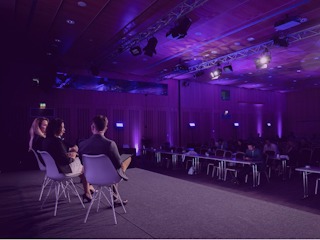October 24, 2024
Mature organizations face increasing pressure to innovate. Whether it's driven by disruptive newcomers to the market or shifting consumer expectations, the need for reinvention has never been greater.
As Mikhail Gorbachev said, “if you're not moving forward, you're moving backward.” This is true for every sector, and businesses that fail to adapt risk being left behind.
In this post, we explore why mature companies must rejuvenate, providing a step-by-step guide to how established businesses can evolve, thrive and remain relevant despite constant disruption.
The case for rejuvenation
Businesses must adapt and evolve. Competition is fiercer than ever, and the pace of change has never been faster.
In the past, the toughest competition came from specific players or geographies, but that's no longer the case. For example, Zara disrupted established fashion brands with its fast time to market, vertical integration and efficient approach to inventory, only to be outpaced by Shein, which offers even faster turnaround and lower prices.
Similarly, Amazon revolutionized the bricks-and-mortar book industry and now dominates online retail as a whole.
Even within industries once considered stable, new entrants are rewriting the rules. For example, digital challenger banks like Monzo, Revolut and Starling are successfully disrupting traditional banking in the UK by offering more personalized, user-friendly experiences.
It's harder for a mature business to adopt a challenger mindset when trying to reinvent itself, pursue new opportunities or respond to competition. The number of options they have for change can appear limited, and they may encounter issues such as outdated systems, established brand image and competing priorities (and stakeholders). Challenger companies don't typically face these issues.
But mature organizations can’t afford to stand still. They must learn from disruptors and seek opportunities to pivot, innovate and break through internal resistance to rejuvenate their practices and deliver long-term success.
Phase 1: Sensing and seizing
For established companies, the rejuvenation process begins with an exercise of sensing and seizing1.
Sensing is an outward look at the market, competitors, customers and threats (current and future) that could affect business operations. After this assessment, the focus shifts inward to evaluate the company’s current capabilities and competitiveness. The goal is to identify the gaps between what the company has and what it needs for the future.
To succeed in the sensing process, it’s crucial to first assess the current situation and recognize how reality has changed. Test assumptions, especially around customer needs and desires, and accept that what has worked in the past may not guarantee future success. Don’t fall into the trap of resting on past achievements. That has been the downfall of many companies.
Seizing starts when a market opportunity is sensed or a development in technology opens up new opportunities. This often requires investment and capability development.
Early on, there are usually several paths to explore. For example, in the early days of engines, steam, internal combustion and electricity were all viable options. Over time, only one became dominant.
Well-positioned companies can often afford to wait and set a direction while struggling companies must act quickly. Notably, companies like Apple and Microsoft were not first movers but still became market leaders — Apple with smartphones and tablets and Microsoft with PCs.
It’s important to note that success is often shaped just as much by organizational choices — such as operating model, business model and internal structures — as by the decision to adopt and implement a specific technology.
Phase 2: Reframing the future
Once a company has a clear understanding of market shifts and opportunities alongside its internal strengths and weaknesses, the next step is reframing the future. This involves rethinking a company’s long-term strategy based on emerging trends, technology advancements and evolving customer preferences.
In this phase, mature companies must look beyond direct competitors and assess broader industry shifts. For example, the rise of subscription-based models in software and entertainment is influencing sectors from automotive to banking.
Then, assess the reviewed strategy and pinpoint gaps in existing capabilities and skills that may prevent you from achieving the revisited strategy. It is during this phase that managers and leaders at successful mature companies often struggle the most. This happens because they fail to see how this pivotal moment will impact them or because they are unable to sell the ideas to others.
It is natural for people to resist change, especially if the foundation of a company’s success (or even someone’s personal success) is becoming obsolete and needs transformation.
However, rejuvenation is about recognizing and balancing competing interests while creating an environment that embraces change. It is much more than throwing money at a problem or simply copying the approach of a new entrant or competitor.
History shows that leaders in mature industries often fail to recognize that all industries, especially traditional industries such as air travel, automotive, banking, retail and fashion, are capable of change. Or that true competitive advantage comes from those willing to take a different approach.
Recent examples of mature industries disrupted by a newcomer embracing advancements in technology or changing customer needs include:
-
Taxis — Uber
-
Automotive — Tesla
-
Hotels — Airbnb
-
Banking — Revolut
-
Airlines — Ryanair
-
Fashion retailers — Shein
-
Ecommerce — Temu
To remain successful, mature companies must remain open to change and, at critical turning points, forge their path forward by building the capabilities needed to achieve their revised strategy.
Phase 3: Starting the change and finding the value
Once a strategy is redefined, it’s time to start implementing changes.
A warning: Tackling the biggest challenges first can lead to high levels of disruption and frustration. Instead, mature companies should focus on achieving small, quick wins to build momentum and gain buy-in from stakeholders.
In Leading Change2, John Kotter suggests an eight-step approach for driving successful change that is incredibly valuable for mature companies navigating rejuvenation. Building on the idea that managers must sell change to others and balance competing interests, Kotter emphasizes the need to create a sense of urgency. This urgency helps gain buy-in and should stem from insights gathered in the first two phases.
He also highlights key steps such as building a coalition, crafting a vision and removing obstacles — intuitive elements for driving change. A key insight is the importance of creating short-term wins. This is based on the idea that people are motivated by success and “an organization has to realize some benefits from a change effort to maintain stakeholder commitment.”
Essentially, early wins build momentum and strengthen the “change coalition.”
However, rejuvenation is more than a series of small victories. It involves setting clear short-, medium- and long-term goals and identifying specific areas for improvement and then identifying vertical thin slices for each.
A vertical thin slice refers to breaking down a problem into smaller, end-to-end features that deliver immediate value once completed. Unlike horizontal slicing, which focuses on specific skills needed for a portion of a problem, vertical thin slicing uses cross-functional collaboration across teams and skill sets to deliver a complete solution.
Once this exercise is completed, an initial change activity should be identified — one with short time to value and low risk. Early success is critical, as this will catalyze momentum and support around broader transformation.
Phase 4: Delivery and the virtuous cycle
The successful delivery of a first quick win is just the beginning. Once an organization begins seeing impact from early results, the transformation journey must continue.
This early success should serve as a springboard for greater ambition. The real challenge comes when a company builds on that first win, daring to aim higher by tackling a more complex thin slice of value — one that requires even greater innovation and collaboration.
As ambition grows, so must an organization’s capacity to take on new challenges. Leaders must create an environment in which teams are empowered to stretch their capabilities, experiment with new ideas and pivot when necessary. The processes that once delivered small wins must evolve to handle larger, more demanding projects.
As confidence and capability grow from earlier successes, so should the organization’s appetite for risk. However, the focus must always remain on the rewards: Delivering value that resonates with customers and stakeholders while positioning the organization to remain competitive over the long term.
This cycle of action, learning and growth drives continuous rejuvenation.
Companies that thrive in mature industries aren’t content with a single win. Instead, they use each victory as a steppingstone toward greater achievements. Rejuvenation is not a destination but an ongoing journey — one that demands both ambition and the courage to raise the stakes with every new challenge.
---
1. David J. Teece, “Explicating Dynamic Capabilities: The Nature and Microfoundations of (Sustainable) Enterprise Performance,” Strategic Management Journal 28, no. 13 (August 7, 2007): 1319–50.
2. Kotter, John P. Leading Change. Boston, Mass.: Harvard Business School Press, 1996.












